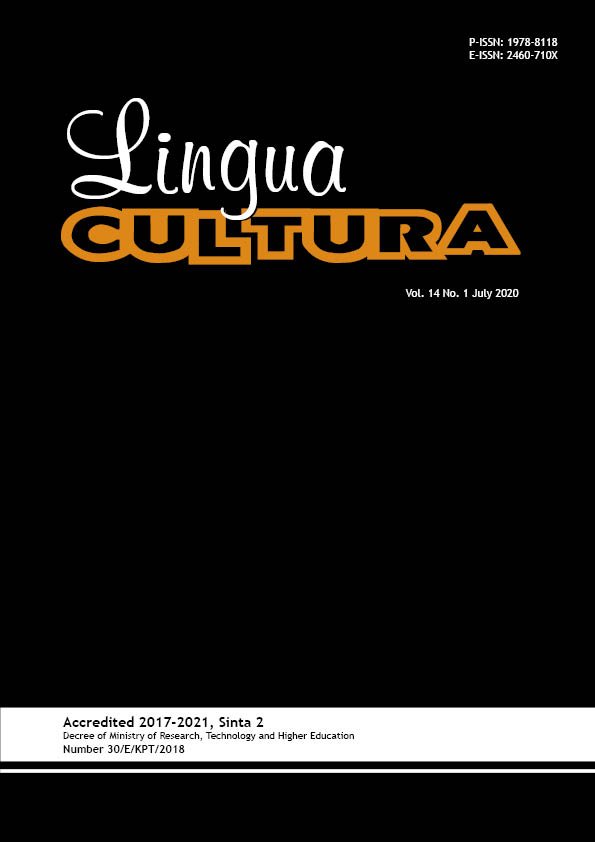Feminism Values in the Posters of Yogyakarta’s Students Demonstration: The #Gejayanmemanggil
DOI:
https://doi.org/10.21512/lc.v14i1.6234Keywords:
feminism values, posters students, students demonstration, discourse analysisAbstract
The research aimed to examine feminism values on the posters of Yogyakarta’s students’ demonstration the #Gejayanmemanggil. Data collection technique was conducted by reading and note-taking techniques. From social media (Instagram), read the posters for several times, made a reduction for the data, and analyzed the feminism values which were reflected in the data based on the discourse or textual aspects. In the findings, the use of feminist languages, which contained the feminism values was revealed, in order to correlate it with the previous studies and theories. It was affected by the positive and negative meanings of the words and their impact on the audience. Discourse analysis was the proper way to examine the hidden ideologies of discourse. It revealed the discursive structures and manipulative language of the speakers or writers. The results reveal that the posters on the demonstration #Gejayanmemanggil contain feminism values as reflected in the feminist languages which support the ideology. Therefore, based on the findings of the research which conducts a discourse analysis in examining mass communication, language has enormous powers in appealing to emotions, manipulating someone’s thoughts and behavior, as well as misrepresenting the realities.Â
References
Abbasi, P., & Moslehi, M. (2016). Ecofeminism and Gilman’s Herland: A gaardian approach. 3L:
Language, Linguistics, Literature, 22(2), 17-29. https://doi.org/10.17576/3L-2016-2202-02.
Al Fajri, M. S. (2017). Hegemonic and minority discourses around immigrants: A corpus-based critical discourse analysis. Indonesian Journal of Applied Linguistics, 7(2), 381-390. https://doi.org/10.17509/ijal.v7i2.8349.
Anshori, D. S. (2016). Gender cognition in religious discourse: A study of framing in thematic holy Koran interpretation. Indonesian Journal of Applied Linguistics, 6(1), 88-98. https://doi.org/10.17509/ijal.v6i1.2741.
Bakar, E. W., Yusof, N. M., & Vengadasamy, R. (2016). Reclaiming voices and disputing authority: A feminist dialogics approach in reading Kee Thuan Chye’s plays. 3L: Language, Linguistics, Literature, 22(1), 97-109. https://doi.org/10.17576/3L-2016-2201-08.
Chang, H. (2017). The body and female identity in Eithne Strong’s Flesh: The Greatest Sin. 3L: Language, Linguistics, Literature, 23(4), 157-169. https://doi.org/10.17576/3L-2017-2304-12.
Dumlao, R. P., & Wilang, J. D. (2019). Variations in the use of discourse markers by L1 and L2 English users. Indonesian Journal of Applied Linguistics, 9(1), 202-209. https://doi.org/10.17509/ijal.v9i1.15206.
Jespersen, O., & Thomsen, V. (Eds). (1921). Language: Its nature development and origin. (Third Edition). New York: Henry Holt & Company.
Kurnia, N. I. (2015). Motherhood in the American woman poet’s perspective: A short glance at Allen’s â€Rock Me to Sleepâ€. Lingua Cultura, 9(2), 113-118. https://doi.org/10.21512/lc.v9i2.829.
Lakoff, R. (2009). Language and woman’s place. Language in Society, 2(1), 45-80.
Manggarrani, M. D., Nababan, M. R., & Santosa, R. (2019). Analisis perbandingan terjemahan ungkapan yang mengandung sikap seksis antara tokoh laki-laki dan perempuan dalam novel Ronggeng Dukuh Paruk. Linguistik Indonesia: Jurnal Ilmiah Masyarakat Linguistik Indonesia, 37(2), 145-158. https://doi.org/10.26499/li.v37i2.105.
Marandi, S. M., Ramin, Z., & Shabanirad, E. (2017). Discourse, power, and resistance in Nadine
Gordimer’s occasion for loving: A foucaultian reading. 3L: Language, Linguistics, Literature, 23(3), 37-49. https://doi.org/10.17576/3L-2017-2303-03.
Nienaber, H., & Moraka, N. V. (2016). Feminism in management research: A route to justly optimise talent. Acta Commercii: Independent Research Journal in the Management Sciences, 16(2), 139-254. https://doi.org/10.4102/ac.v16i2.417.
Oluga, S. O., Seng, T. C., & Rajoo, G. S. R. (2016). Replication, evocation and revocation of linguistic sexism in translated national anthems. 3L: Language, Linguistics, Literature, 22(2), 209-226. https://doi.org/10.17576/3L-2016-2202-15.
Ramanathan, R., & Tan, B. H. (2015). Application of critical discourse analysis in media discourse studies. 3L: Language, Linguistics, Literature, 21(3), 57-68.
Shamsuddin, C. M., & Hamid, B. A. (2017). Representational meanings of gender stereotyped professional occupation images in selected Malaysian English language textbooks. 3L: Language, Linguistics, Literature, 23(4), 128-142. https://doi.org/10.17576/3L-2017-2304-10.
Sudaryanto. (2015). Metode dan aneka teknik analisis bahasa (First Edition). Yogyakarta: Universitas Sanata Dharma.
Suryaningrum, S., Suwandi, S., & Waluyo, H. J. (2019). The discrimination against women reflected in novels â€Entrokâ€, â€Maryamâ€, and â€Pasung Jiwa†by Okky Madasari. Lingua Cultura, 13(2), 137-143. https://doi.org/10.21512/lc.v13i2.5704.
Udasmoro, W. (2017). Destabilizing gender norm in contemporary Indonesian discourses (Destabilisasi norma gender dalam wacana Indonesia kontemporer). Mozaik Humaniora, 17(2), 291-303. http://dx.doi.org/10.20473/mozaik.v17i2.6072.
Yusuf, Y. Q., Natsir, Y., & Yusra, S. R. (2016). Dont 4get 2 txt me plz! Linguistic and discoursal features of short message service by female texters. 3L: Language, Linguistics, Literature, 22(1), 81-96. https://doi.org/10.17576/3L-2016-2201-07.
Zeiny, E. (2019). Ecriture feminine: Feminism and nationalism in Seyyedeh Zahra Hosseini’s
â€One Woman’s War: Daâ€. 3L: Language, Linguistics, Literature, 25(3), 115-125. https://doi.org/10.17576/3L-2019-2503-09.
Downloads
Published
How to Cite
Issue
Section
License
Copyright (c) 2020 Lingua Cultura

This work is licensed under a Creative Commons Attribution-ShareAlike 4.0 International License.
Authors who publish with this journal agree to the following terms:
a. Authors retain copyright and grant the journal right of first publication with the work simultaneously licensed under a Creative Commons Attribution License - Share Alike that allows others to share the work with an acknowledgment of the work's authorship and initial publication in this journal.
b. Authors are able to enter into separate, additional contractual arrangements for the non-exclusive distribution of the journal's published version of the work (e.g., post it to an institutional repository or publish it in a book), with an acknowledgment of its initial publication in this journal.
c. Authors are permitted and encouraged to post their work online (e.g., in institutional repositories or on their website) prior to and during the submission process, as it can lead to productive exchanges, as well as earlier and greater citation of published work.
USER RIGHTS
All articles published Open Access will be immediately and permanently free for everyone to read and download. We are continuously working with our author communities to select the best choice of license options, currently being defined for this journal as follows: Creative Commons Attribution-Share Alike (CC BY-SA)


















